How to Address Behavioral Issues in Bengal Cats
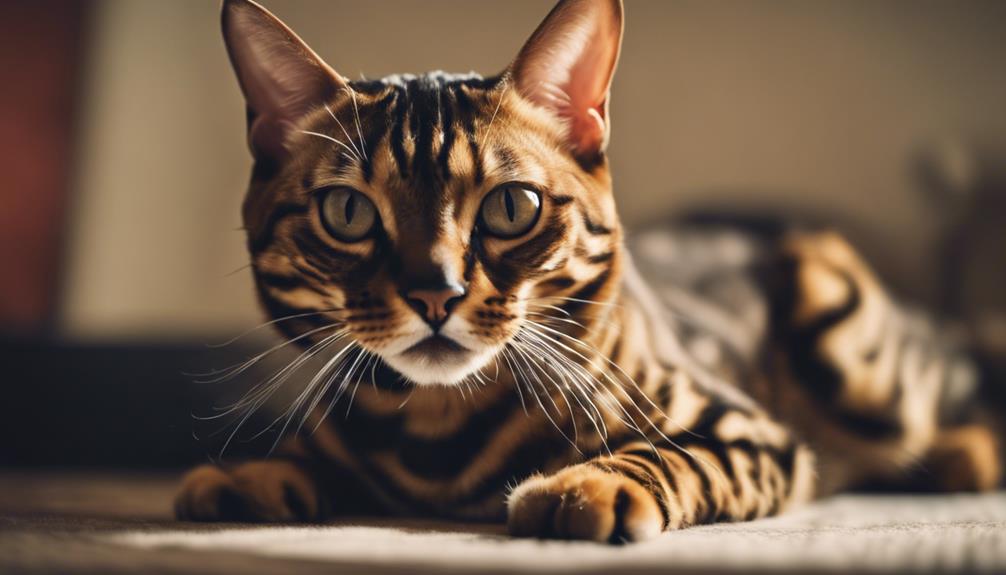
Bengal cats are known for their high prey drive and sometimes aggressive behavior. To address these issues, it is important to provide plenty of interactive toys and playtime to satisfy their hunting instincts. Engaging in regular play sessions can help redirect their energy towards appropriate outlets. Additionally, providing vertical spaces such as cat trees and shelves can give them opportunities to climb and observe their surroundings, which can help alleviate boredom and reduce aggressive behaviors. Socialization with other pets and positive reinforcement training can also be effective in managing their behavior. If behavioral issues persist, seeking guidance from a veterinarian or animal behaviorist is recommended for a tailored treatment plan.
Remember, every cat is unique, and it may take time to find the right approach that works for your Bengal cat. With patience, consistency, and understanding, you can help your Bengal cat thrive in a safe and happy environment.
Understanding Bengal Cat Behavior
Understanding the behavior of Bengal cats is crucial for pet owners to create a harmonious and fulfilling relationship with these intelligent and social felines. Bengals' ancestry traces back to Asian leopard cats, which contribute to their unique traits. These cats are known for their high energy levels, curiosity, and need for mental stimulation. However, these same characteristics can sometimes lead to behavioral issues such as peeing outside the litter box, clawing furniture, or biting.
To discipline a Bengal cat effectively, pet owners should focus on redirecting their behavior rather than using punishment. Bengals respond well to positive reinforcement, so rewarding good behavior is key. Additionally, providing ample opportunities for exercise, play, and mental stimulation can prevent many behavioral problems before they arise.
Understanding the root cause of a Bengal cat's behavior issues is essential; often, these behaviors stem from unmet needs or stress. By addressing these underlying factors with sensitivity and patience, pet owners can foster a healthy and balanced relationship with their Bengal companion.
Identifying Common Behavioral Issues

Behavioral issues such as aggression towards humans and destructive scratching behaviors are prevalent in Bengal cats. These behaviors can result from various factors like their natural instincts and need for physical activity.
Identifying these common issues is the first step in effectively addressing and managing them for a healthier relationship with your Bengal cat.
Aggression Towards Humans
When addressing aggression towards humans in Bengal cats, it's important to identify the underlying causes to effectively address and modify this behavior. Aggressive behavior in Bengal cats, such as hissing, growling, swatting, or biting, can stem from fear, stress, or insufficient socialization.
Understanding triggers like loud noises or sudden movements is crucial in managing aggression. It's also essential to rule out any pain or discomfort by scheduling a vet check-up.
Positive reinforcement techniques, like rewarding good behavior, and desensitization methods, such as gradual exposure to stressors, can aid in reshaping the cat's behavior. By approaching the issue with patience, consistency, and understanding, owners can help their Bengal cats overcome aggression towards humans.
Destructive Scratching Behaviors
Bengal cats commonly exhibit destructive scratching behaviors as a result of their innate territorial marking instincts and the need to maintain claw health. This behavior can serve as a form of communication or stress relief for these cats, but if not redirected appropriately, it can lead to damage to furniture and other household items.
To address this issue, providing suitable scratching posts with different textures is essential. These posts can help fulfill the cats' natural instincts while protecting your belongings. Additionally, regular nail trimming and engaging play sessions can help reduce the urge for destructive scratching behaviors.
Understanding the underlying reasons for the scratching, such as boredom or lack of mental stimulation, is crucial in effectively addressing and correcting this behavior in Bengal cats.
Implementing Positive Reinforcement Techniques
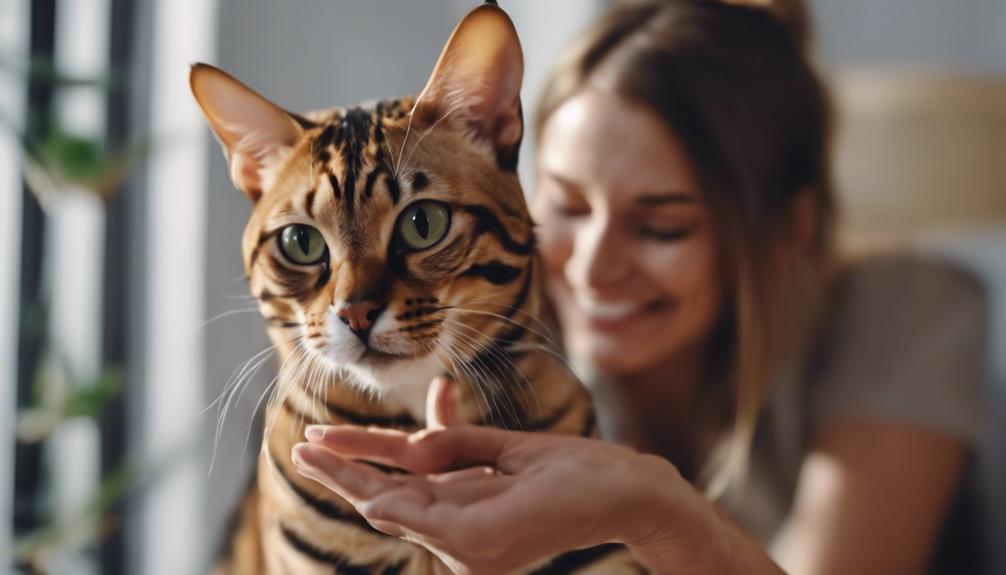
When training Bengal cats, it's crucial to focus on positive reinforcement techniques. Rewards for good behavior, consistent praise, and treats are effective tools in shaping desired behaviors.
Redirecting negative behaviors through positive reinforcement helps foster a strong bond between the owner and their Bengal cat.
Rewards for Good Behavior
To effectively reinforce good behavior in Bengal cats, owners can utilize positive reinforcement techniques by rewarding desired actions with treats or praise. Rewarding good behavior is essential in shaping the behavior of Bengal cats positively. Consistency in providing rewards is key to ensuring the reinforcement is effective. Rewards can vary from favorite treats to extra playtime or verbal praise, depending on what motivates the individual cat. By using positive reinforcement, Bengal cat owners can strengthen the bond with their pets while addressing any behavioral issues that may arise. Here is a table summarizing the importance of rewards for good behavior:
| Rewarding Good Behavior in Bengal Cats |
|---|
| Encourages positive actions |
| Reinforces desired behaviors |
| Strengthens the bond with the cat |
| Enhances training effectiveness |
| Promotes a happy and well-behaved cat |
Consistent Praise and Treats
Implementing positive reinforcement techniques with consistent praise and treats is crucial for reinforcing desired behaviors in Bengal cats effectively. Positive reinforcement involves promptly and consistently rewarding good behavior. In the case of Bengal cats, it's essential to provide immediate praise to establish a direct connection with the desired action.
When offering treats, opt for high-value ones and ensure they're given right after the behavior to strengthen the association. Consistency plays a vital role in utilizing positive reinforcement to address behavioral issues in Bengal cats. By consistently praising and rewarding your Bengal cat for positive behaviors, you can effectively encourage and maintain those desired actions while fostering a stronger bond between you and your feline companion.
Redirect Negative Behaviors
To effectively address behavioral issues in Bengal cats, redirecting negative behaviors through positive reinforcement techniques is key in fostering positive changes in their actions and habits. When implementing positive reinforcement strategies with Bengal cats, consider the following:
- Consistent Rewards: Reward good behavior promptly and consistently to reinforce positive actions effectively.
- Redirecting Inappropriate Scratching: Direct Bengal cats to appropriate scratching posts by rewarding them when they use the designated areas.
- Encouraging Litter Box Use: Use positive reinforcement to encourage Bengal cats to use the litter box consistently by rewarding them after successful use.
- Creating Positive Associations: Associate desired behaviors with positive experiences like playtime or treats to encourage long-term behavioral improvements.
Creating a Cat-Friendly Environment
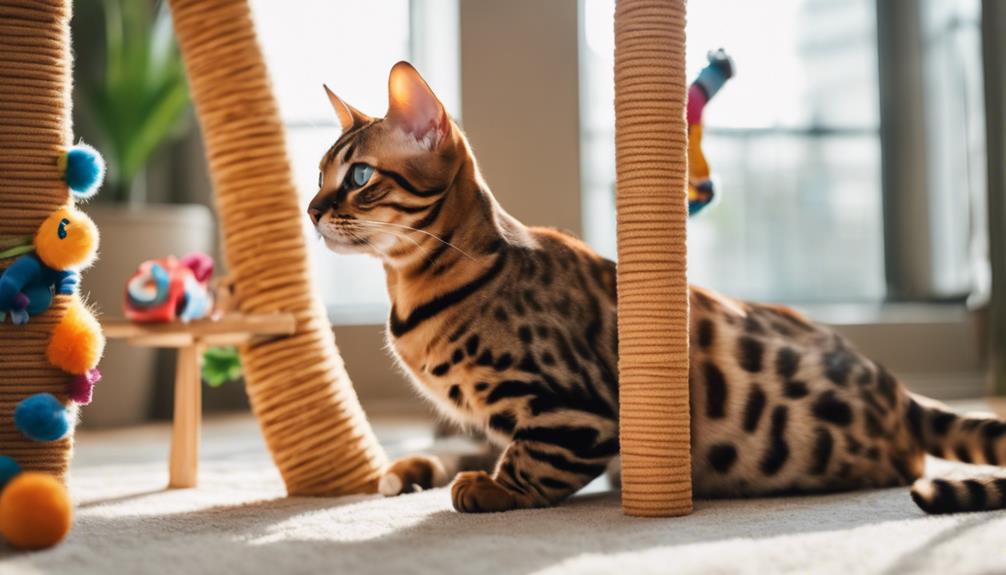
Creating a cat-friendly environment for Bengal cats involves providing appropriate alternatives like scratching posts to prevent unwanted scratching behavior. By offering durable scratching posts that cater to a Bengal cat's natural instincts, owners can redirect their pets' scratching tendencies away from furniture and onto more suitable surfaces.
Encouraging positive behavior by praising and rewarding cats when they use designated scratching areas can reinforce this desired conduct. Additionally, using treats and scents to attract Bengal cats to these designated spots can help in establishing a cat-friendly environment.
Investing in scratching posts that are sturdy and tall enough for Bengals to fully stretch and scratch on can also aid in minimizing destructive behavior. It's vital for owners to exercise patience as cats adjust to these changes, as behavior modifications take time.
Addressing Aggression in Bengals
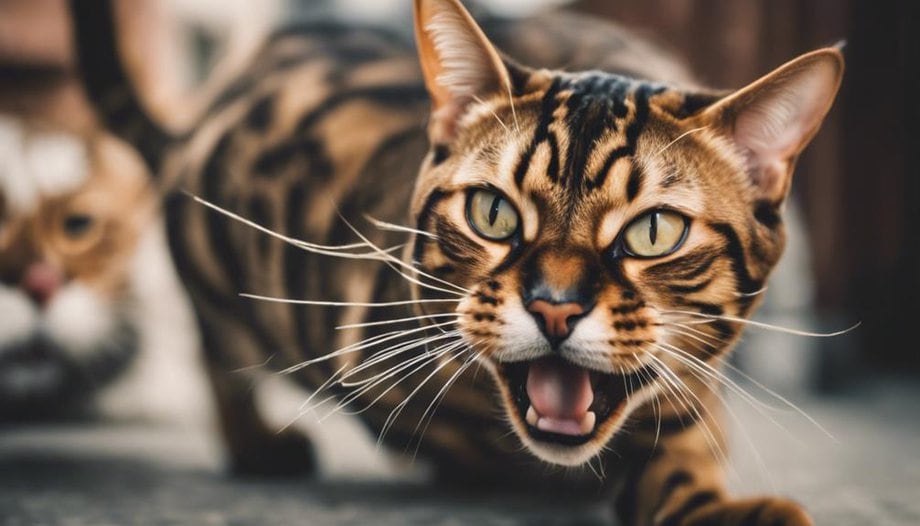
When addressing aggression in Bengal cats, it's crucial to understand that this behavior can stem from various underlying factors such as hyperactivity and under-stimulation. Addressing aggression in Bengal cats requires patience, understanding, and appropriate techniques.
- Compassion is Key: Approaching the cat with kindness and empathy can help in de-escalating aggressive behaviors.
- Training Techniques: Utilizing positive reinforcement methods can aid in redirecting aggressive tendencies towards more acceptable behaviors.
- Play-Related Behavior: Recognizing that aggression in Bengal cats might be linked to play can help in managing and channeling their energy effectively.
- Consequences of Untreated Aggression: Ignoring or mishandling aggression can lead to further issues, potentially endangering the well-being of both the cat and its owners.
Managing Litter Box Problems
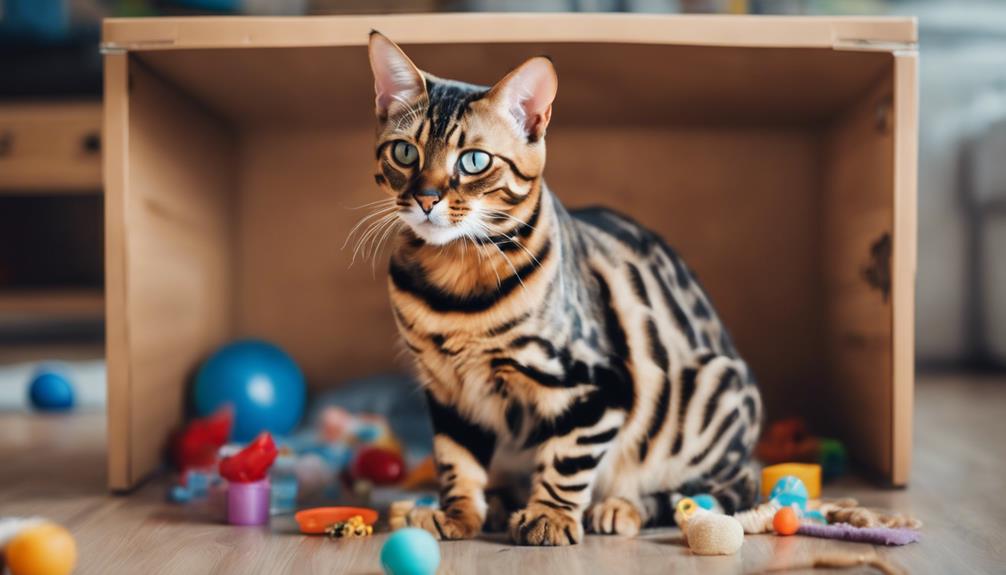
Understanding Bengal cats' litter box problems is essential for maintaining their health and well-being. Bengal cat behavior problems related to litter box use can often be managed effectively through simple strategies.
Providing multiple litter boxes in various locations gives Bengals options for elimination, catering to their preferences. Using unscented, clumping litter can appeal to their sensitive noses and textures they prefer. Regularly cleaning the litter boxes ensures a hygienic environment that Bengal cats will find comfortable using. Placing the litter boxes away from noisy or high-traffic areas offers them privacy during elimination.
Monitoring your Bengal cat's litter box habits closely is crucial to detect any changes that might indicate underlying health issues. By implementing these measures, you can help prevent and address litter box problems, promoting your Bengal cat's well-being and overall health.
Seeking Professional Help When Needed

To address persistent Bengal cat behavioral problems effectively, consulting a vet is crucial for guidance and potential solutions, especially if the issues are complex. Vets may recommend seeking assistance from an animal trainer or behaviorist to provide specialized help. Here are some key points to consider when seeking professional help for Bengal cat behavior:
- Compassionate Care: Vets offer compassionate care and understanding when dealing with aggression problems in Bengal cats.
- Expert Guidance: Animal trainers can provide expert guidance on behavior modification techniques tailored to your cat's needs.
- Medical Insight: Vet consultations can uncover underlying medical issues contributing to behavioral problems, ensuring a holistic approach to treatment.
- Tailored Solutions: Professionals can offer tailored advice and strategies to manage specific behavior issues, improving the overall well-being of your Bengal cat.
Frequently Asked Questions
How Do You Discipline a Bengal Cat?
When disciplining a Bengal cat, it's crucial to focus on positive reinforcement, consistent boundaries, and redirecting aggression. By using training methods that incorporate rewards and establishing routines, one can effectively modify behavior and foster a harmonious relationship.
How Do You Deal With a Cat With Behavioral Issues?
When dealing with a cat with behavioral issues, one must focus on positive reinforcement, clicker training, environmental enrichment, behavior modification, consistent routines, and seeking professional help. These strategies help address the root cause and promote positive results.
How Do I Get My Bengal Cat to Stop Attacking?
To get a Bengal cat to stop attacking, encourage play therapy with interactive toys, use positive reinforcement, and redirect aggression. Consistent training and behavior modification techniques can help address the issue effectively, promoting a harmonious relationship.
How Do You Calm a Bengal Cat?
To calm a Bengal cat, engage in play therapy using interactive toys and provide environmental enrichment with vertical spaces. Utilize calming techniques like pheromone diffusers and establish a routine for positive reinforcement. Seek advice on behavioral modification from professionals.











